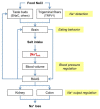Salt Taste, Nutrition, and Health
- PMID: 32466165
- PMCID: PMC7284473
- DOI: 10.3390/nu12051537
Salt Taste, Nutrition, and Health
Abstract
The sodium ion (Na+) is essential for life [...].
Conflict of interest statement
The authors declare no conflict of interest.
Figures

References
Publication types
MeSH terms
Substances
LinkOut - more resources
Full Text Sources

